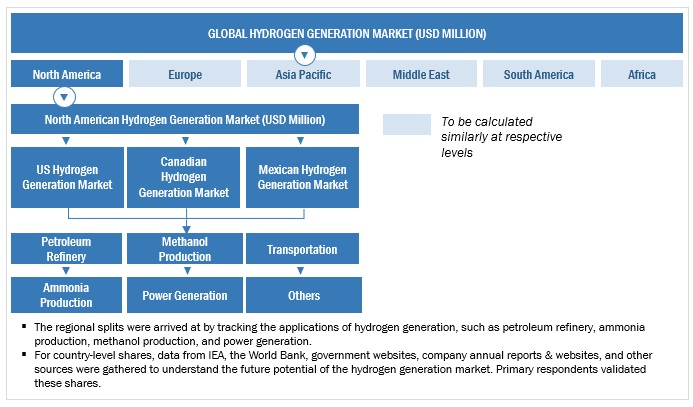
Global Hydrogen Generation Market Scenario
The global hydrogen generation market is projected to reach USD 257.9 billion by 2028 from an estimated USD 158.8 billion in 2023, at a CAGR of 10.2% during the forecast period. The rising safety concerns, increasing focus on renewable energy, and the growing demand for electricity is driving the growth of the hydrogen generation market.
Due to their strong supply network, a few global and regional players hold a strong foothold in the hydrogen generation market. Linde plc (Ireland), Air Liquide (France), Air Products and Chemicals, Inc. (US), Saudi Arabian Oil Co. (Saudi Arabia), and Shell plc (UK) are the market leaders in the hydrogen generation market. These companies have adopted strategies such as product launches, partnerships, acquisitions, and expansions to increase their market share.
Download PDF Brochure – https://www.marketsandmarkets.com/requestsampleNew.asp?id=494
Hydrogen Generation Market Size: Top-Down Approach

Linde plc provides industrial gases and high-quality engineering solutions, technologies, and services. The company is the largest industrial gas firm globally in terms of market share and revenue. It operates through five business segments: Americas, EMEA, APAC, Engineering, and Other. It serves customers from the healthcare, petroleum refining, manufacturing, food & beverage carbonation, fiber optics, aerospace, chemical, electronics, and water treatment verticals.
Saudi Arabian Oil Co., also known as Saudi Aramco, is a Saudi state-owned oil firm and one of the world’s largest integrated energy corporations. The company operates under three main business segments, namely, Downstream, Upstream, and Corporate.Saudi Arabian Oil Co. offers hydrogen through the Upstream segment.
Air Products and Chemicals, Inc. is a leading global industrial gas company providing its services for developing, engineering, building, and operating industrial gas projects. The company has five business segments, namely, Americas, Europe, Asia, Middle East and India, and Corporate and Other. It offers products and solutions to produce atmospheric, process, and specialty gases and related services.
This research report categorizes the hydrogen generation market based on source, technology, generation and delivery mode, application and region.
On the basis of source:
- Blue hydrogen
- Gray Hydrogen
- Green Hydrogen
On the basis of technology:
- Steam Methane Reforming (SMR)
- Partial Oxidation (POX)
- Auto Thermal Reforming (ATR)
- Coal Gasification
- Electrolysis
On the basis of application:
- Petroleum Refinery
- Transportation
- Ammonia Production
- Methanol Production
- Power Generation
- Others
On the basis of generation and delivery mode:
- Captive
- Merchant
On the basis of region:
- North America
- Europe
- Asia Pacific
- South America
- Middle East
- Africa
Key Stakeholders
- Energy Regulators
- Consulting companies in the energy and power sector
- Distributors of hydrogen energy solutions
- Governments and research organizations
- Power equipment and garden tool manufacturers
- Hydrogen producers
- Spare parts and component suppliers
Objectives of the Study
- To define, describe, and forecast the hydrogen generation market based on source, technology, generation and delivery mode, and end user in terms of value
- To define, describe, and forecast the market across five key regions, namely, North America, Europe, Asia Pacific, South America, Middle East, and Africa, along with the country-level market analyses in terms of value
- To provide detailed information about industry-specific key drivers, restraints, opportunities, and challenges influencing the growth of the market
- To strategically analyze the hydrogen generation market with respect to individual growth trends, prospects, and contributions of each segment to the market
- To provide information pertaining to the supply chain, trends/disruptions impacting customers’ businesses, market mapping, pricing of hydrogen, and regulatory landscape pertaining to the market
- To strategically analyze the micromarkets1 with respect to individual growth trends, upcoming expansions, and their contributions to the overall market
- To analyze opportunities for stakeholders in the market and draw a competitive landscape for market players
- To benchmark players within the market using the company evaluation matrix, which analyzes market players on various parameters within the broad categories of business and product strategies
- To compare key market players with respect to the market share, product specifications, and applications
- To strategically profile key players and comprehensively analyze their market ranking and core competencies2
- To track and analyze competitive developments in the hydrogen generation market, such as expansions, product launches, partnerships, and acquisitions.
Request Sample Pages – https://www.marketsandmarkets.com/requestsampleNew.asp?id=494
Asia Pacific is expected to be the fastest-growing region in the hydrogen generation market.
Asia Pacific is expected to be the fastest growing region in the hydrogen generation market during the forecast period. The Asia Pacific region comprises major economies such as China, Japan, India, Australia, and South Korea. The hydrogen generation market in Asia Pacific is primarily fueled by the increasing number of petroleum refineries and usage of hydrogen in these refineries. Asia Pacific is one of the leading markets for adopting green technologies to meet the government targets for reducing GHG emissions. Japan and South Korea have been heavily investing in fuel cell adoption since 2009 because of the commercial deployment of Japanese fuel cell micro-CHP products. Japan is the first nation to commercialize fuel cells and is supporting projects related to the use of fuel cells in residential and automotive applications. It aims to deploy green hydrogen on a large scale. The country plans to have 200,00 green hydrogen fuel cell vehicles and 320 hydrogen refueling stations by 2025 to meet the global carbon emission standards.